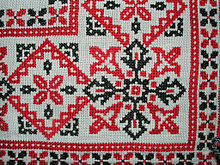Embroidery
Embroidery is the handicraft of decorating fabric or other materials with needle and thread or yarn. Embroidery may also incorporate other materials such as metal strips, pearls, beads, quills, and sequins.Embroidery is most often used on caps, hats, coats, blankets, dress shirts, denim, stockings, and golf shirts.
Embroidery is available with a wide variety of thread or yarn color.
An interesting characteristic of embroidery is that the basic techniques or stitches on surviving examples of the earliest embroidery—chain stitch, buttonhole or blanket stitch, running stitch, satin stitch, cross stitch—remain the fundamental techniques of hand embroidery today.
Classification
Embroidery can be classified according to whether the design is stitched on top of or through the foundation fabric, and by the relationship of stitch placement to the fabric.
In free embroidery, designs are applied without regard to the weave of the underlying fabric. Examples include crewel and traditional Chinese and Japanese embroidery.
Counted-thread embroidery patterns are created by making stitches over a predetermined number of threads in the foundation fabric.
Counted-thread embroidery is more easily worked on an even-weave foundation fabric such as embroidery canvas, aida cloth, or specially woven cotton and linen fabrics although non-evenweave linen is used as well.
Examples include needlepoint and some forms of blackwork embroidery.
In canvas work threads are stitched through a fabric mesh to create a dense pattern that completely covers the foundation fabric.
Traditional canvas work such as bargello is a counted-thread technique.
Since the 19th century, printed and hand painted canvases, on which the printed or painted image serves as a guide to the placement of the various thread or yarn colors, have eliminated the need for counting threads.
These are particularly suited to pictorial rather than geometric designs such as those deriving from the Berlin wool work craze of the early 19th century.
In drawn thread work and cutwork, the foundation fabric is deformed or cut away to create holes that are then embellished with embroidery, often with thread in the same color as the foundation fabric. These techniques are the forerunners of needlelace.
When created with white thread on white linen or cotton, this work is collectively referred to as whitework.




No comments:
Post a Comment